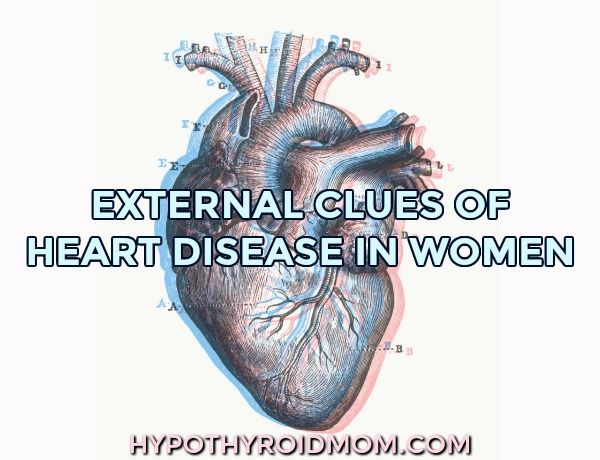
Do you know that the American Heart Association and the American College of Cardiology Foundation issued joint guidelines in 2013 recommending that doctors test thyroid hormone levels in every single patient with heart failure?[1]
When a doctor with 4 board certifications wrote to me about these 7 unusual, or so they seemed to me at first, external clues of heart disease in women, my curiosity was thoroughly piqued. I found myself in front of the mirror checking for these signs and I know you will too.
As a young doctor, Dr. Menolascino worked on the high profile Heart Disease Reversal program with Dr. Dean Ornish. There was one thing that puzzled him. All the participants were men.
“Where are the women?” became his mission.
Written by Mark Menolascino, MD
Heart disease remains the number one killer of women, outpacing breast cancer, diabetes, and stroke, with one in four women receiving a diagnosis in her lifetime.
EARLOBE CREASE
A crease in both earlobes is now proven to be correlated with an increased risk of heart disease and particularly sudden death from heart disease. This may be due to higher oxidative stress/inflammation in the body and can cause an increased risk of heart attack.[2,3]
ABNORMAL PUPILS
Enlarged pupils in a brightly lit room suggest an overactive or imbalanced nervous system and confused adrenal glands. If after shining a bright light into your eyes, your pupils first reduce in size and expand again slightly, it may be an indication of adrenal dysregulation and cortisol abnormalities.
ARCUS SENILIS
The arcus senilis is a small blue circle surrounding the colored part of the center of the eye and is a well-proven indicator of heart health. This blue circle can be an indicator of abnormal cholesterol processing and overall elevated cholesterol levels.[4]
RUDDY CHEEKS
Ruddiness in the cheeks can indicate internal inflammation and is common among people with diabetes, which increases the risk of being admitted to the hospital for severe heart problems.
DARK SKIN AREAS
Darkness under the eyes and on the back of the neck suggest blood sugar abnormalities, including diabetes and insulin resistance.[5] Dark areas under the armpits may also be signs of blood sugar imbalance.
SKIN BUMPS AND TAGS
Small bumps on the back of the arms are commonly related to food sensitivities such as dairy. When you heal your gut and remove inflammatory foods, these bumps tend to disappear. Small skin tags can be related to abnormal cholesterol metabolism, especially a concern when seen around the eyes.[6,7]
FINGERNAIL ABNORMALITIES
Fingernails give us clues to your body’s nutrient absorption and digestive function. White spots on the nails may indicate zinc deficiency or diabetes. Pitting of the nails is usually a sign of overall nutrient deficiency or psoriasis. Flat thumbnails with “feathered” appearing ridges are an indication that you are probably not optimally utilizing nutrition because of either poor intake or gut dysfunction.
The nails are so sensitive to nutrition that if you are hospitalized for a major illness, such as a heart attack, a white horizontal line on your fingernails and thumbnails will develop as a large ridge that marks that event, reflecting how poorly your body was functioning (called Beau’s lines).[8] As you recover, your nails stop forming the white lines as they grow out.
About Mark Menolascino, MD
Dr. Mark Menolascino is the medical director of the Meno Clinic Center for Functional Medicine, located in Wyoming. He is an MD with board certifications in Internal Medicine, Holistic Medicine, Hormone Management, and Anti-Aging Medicine. He also has master’s degrees in pharmacology and immunology.
References:
1.Yancy, C.W., et al. 2013 ACCF/AHA Guideline for the Management of Heart Failure: A Report of the American College of Cardiology Foundation/American Heart Association Task Force on Practice Guidelines. 2013 Oct 15;62(16):e147-e239.
2. Shmilovich. H., et al. Relation of Diagonal Ear Lobe Crease to the Presence, Extent, and Severity of Coronary Artery Disease Determined by Coronary Computed Tomography Angiography. 2012 May 1;109(9):1283-1287.
3. Christoffersen, M., et al. Visible Age-Related Signs and Risk of Ischemic Heart Disease in the General Population. Circulation. 2014;129:990-998.
4. Ang, M., et al. Corneal Arcus is a Sign of Cardiovascular Disease, Even in Low-Risk Persons. American Journal of Ophthalmology. 2011 Jul;152(5):864-71.e1.
5. Guevara-Gutiérrez, E., et al. A study of the association of acanthosis nigricans with subclinical atherosclerosis. Indian J Dermatol Venereol Leprol. 2017;83:190-4.
6. Swivedi, S., Jhamb, R. Cutaneous markers of coronary artery disease. World J Cardiol. 2010 Sep 26;2(9):262-269.
7. Nair, P.A., et al. Xanthelasma Palpebrarum with Arcus Cornea: A Clinical and Biochemical Study. Indian J Dermatol. 2016 May-Jun;61(3):295-300.
8. Fawcett, R.S., et al. Nail Abnormalities: Clues to Systemic Disease. American Family Physician. 2004 Mar 15;69(6):1417-1424.
READ NEXT: HYPOTHYROIDISM & HEART DISEASE


I have had hypothyroidism since 12 years old and have a myriad of issues with Dr’s helping navigate how much thyroid I should be taking. Now at 44 just several weeks ago I started to get skipped heartbeats, to the point I am woken up from sleep and feel tired all the time. Dr immediately wanted to say I have high anxiety. I was disheartened and requested a halter monitor. But unsure what to do now?
I hope you are feeling better Heather.